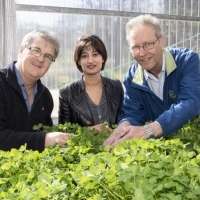Decoding clover DNA leads to better livestock productivity

Western Australian and Japanese scientists have together cracked the genome sequence of the subterranean (sub) clover.
The project led by The University of Western Australia in collaboration with Department of Agriculture and Food, Murdoch University and the Kazusa DNA Research Institute, will revolutionise the development of new and improved forage legumes, which underpin the State's $1.8 billion livestock industry.
Clovers are widely grown around the world as forage legumes for livestock and they add nitrogen to the soil which assists crop production.
Sub clover is the most important annual pasture legume in Australia, sown across an estimated 29 million hectares of agricultural land.
UWA Molecular Biologist Dr Parwinder Kaur said the challenge was not only to determine the sequence of sub clover DNA but to understand the genes from a functional point of view.
"The changes provide a breakthrough for breeding of future sub clovers which will increase agriculture production by increasing the health of the soil.
"This is the first genome sequence published for an annual clover and describes 85.4 per cent of the sub clover genome and contains 42,706 genes. It represents years of research and a commitment to creating new knowledge that will feed our future."
Department senior pasture breeder and UWA Adjunct Associate Professor Phil Nichols said the discovery had important benefits for the agriculture industry.
"This work will allow the development of DNA markers that are closely associated with genes controlling traits of interest, which can be used in breeding programs to markedly improve selection efficiency, particularly for traits difficult to measure in the field or glasshouse," Dr Nichols said.
"Such traits include resistance to redlegged earth mites and important diseases, hardseededness, tolerance to false breaks, early season growth under cool temperatures, phosphorus use efficiency, phtyo-oestrogen content, methanogenic potential in the rumen, flowering time and other traits related to biomass production."
The work was funded through the Science and Innovation Award by Australian Department of Agriculture and Water Resources, Meat and Livestock Australia and the Australian Research Council.
UWA Centre for Plant Genetics and Breeding Director Professor William Erskine said this understanding of the sub clover genome would also aid breeding programs of other important pasture legumes with more complex genomes, such as white and red clovers, annual medics and lucerne.
The research paper has been published in the prestigious Nature journal Scientific Reports.
More information: Hideki Hirakawa et al. Draft genome sequence of subterranean clover, a reference for genus Trifolium, Scientific Reports (2016). DOI: 10.1038/srep30358
Journal information: Scientific Reports
Provided by University of Western Australia




















